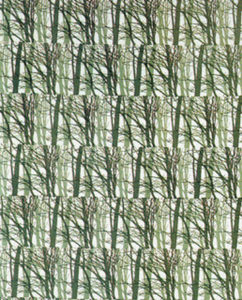 By Anne Gilbert
By Anne Gilbert If you are searching for authentic wallpaper and fabrics made in the 1940s/50s they are scarce but can be costly. However the good news is that even small pieces have been reborn as pillow cases or framed as art. Originally they may have been drapes or furniture fabrics. Or, magnificent murals or wallpaper.
After World War 11 a new generation of home owners were looking for something different from the standard textiles and furnishings they had grown up with. Along with the new plastics and metal furnishings fabrics and wallpapers offered such innovations as foil wallpaper and hand-woven fabrics for furniture with totally different designs formed from circles, squares and rectangles. Goodbye stuffy upholstery and standard floral wallpaper.
This was also the first extensive time of travel and the rediscovery of the far east. American architect Jim Thompson in Bancock made Tai silks a “must’ for decorators.
Rugs and carpets embraced the new look. Some of the most popular were the Scandinavian rugs. They used a variety of techniques ranging from Rya rugs with deep pile, coarse and fine tufts and abstract designs. The Scandinavians also made reversible flat weave carpets with abstract motifs.
Shag rugs and carpets replaced one popular flat Oriental rugs and carpets.
 Wallpaper and window fabrics became an important part of the modern look for young marrieds furnishing new homes and apartments. Adding to their appeal: they were inexpensive and were made of new materials that included “bark cloth” and shiny foil. Often they became works of art inspired by Picasso, Joan Miro and others. Texture and weaving were newly important. One of the top weavers of the era was Dorothy Liebes of San Francisco. Another important name was Jack Lenor Larsen. He developed the hand woven look using power looms. He also introduced new palettes of earth tones.
Wallpaper and window fabrics became an important part of the modern look for young marrieds furnishing new homes and apartments. Adding to their appeal: they were inexpensive and were made of new materials that included “bark cloth” and shiny foil. Often they became works of art inspired by Picasso, Joan Miro and others. Texture and weaving were newly important. One of the top weavers of the era was Dorothy Liebes of San Francisco. Another important name was Jack Lenor Larsen. He developed the hand woven look using power looms. He also introduced new palettes of earth tones.
While designers involved in mid-century modern motifs were from around the world, among the most important came from Chicago and New York. Chicagoans Jack Denst and Ben Rose among them. Denst was known for his gigantic wall murals. Rose was known for his hand-screened prints on fabrics and paper. CLUES: There are still authentic examples of the original 50’s wallpapers and fabrics available. Check out the dealers and eBay on the internet. However, there are also reproductions being passed off. It doesn’t matter if you are only interested in the “look.”
To learn more check out my book, “40s, 50s Designs and Memorabilia” still in print. While the prices listed are outdated they can be compared with current ones since the 1993 publication.
 PHOTO CAPTION (1) Textile design “Groves” c. 1954. Ben Rose (1916-20040 PHOTO CREDIT: The Art Institute of Chicago PHOTO CAPTION (2) Muray “Dance of the Dolphins”. Jack Denst (1916 -2009) PHOTO CREDIT: Dwell PHOTO CAPTION :((3) Textile “Remoulade” by Jack Lenor Larsen , 1953 PHOTO CREDIT: Goldstein Museum of Design PHOTO CAPTION: (4) Textile. Pillow. “Pebbles” pattern. PHOTO CREDIT: Private collector
PHOTO CAPTION (1) Textile design “Groves” c. 1954. Ben Rose (1916-20040 PHOTO CREDIT: The Art Institute of Chicago PHOTO CAPTION (2) Muray “Dance of the Dolphins”. Jack Denst (1916 -2009) PHOTO CREDIT: Dwell PHOTO CAPTION :((3) Textile “Remoulade” by Jack Lenor Larsen , 1953 PHOTO CREDIT: Goldstein Museum of Design PHOTO CAPTION: (4) Textile. Pillow. “Pebbles” pattern. PHOTO CREDIT: Private collector














Follow Us